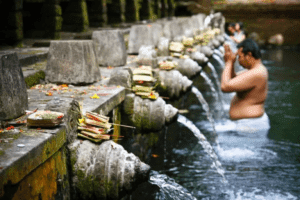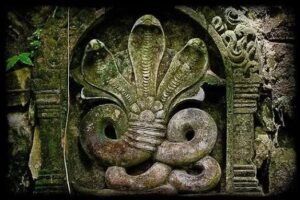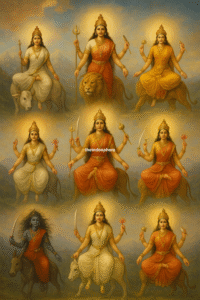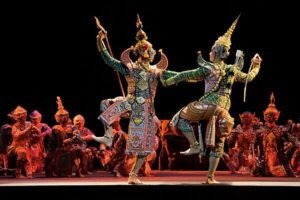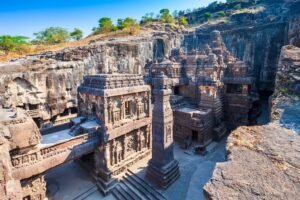Hinduism is home to a vast array of sacred texts that explore the relationship between gods and humans, good and evil, and the universe’s eternal cycles of creation and destruction. One such revered text is the Devi Mahatmya—also known as the Durga Saptashati or Chandi Path. This ancient scripture holds a special place in the hearts of millions of devotees, especially those who revere the Goddess or Devi as the ultimate source of power.

What is the Devi Mahatmya?
Meaning: The Devi Mahatmya is part of a larger Hindu scripture called the Markandeya Purana, written around the 5th to 6th century CE. The term “Devi Mahatmya” translates to “The Glory of the Goddess” and is also known as Durga Saptashati or Chandi Path. It is a revered text that highlights the triumph of the Goddess over various evil forces. It is primarily dedicated to Goddess Durga, a powerful female deity representing Shakti—the divine feminine force in Hindu cosmology.
Content: It consists of 700 verses (hence “Saptashati“) divided into 13 chapters. The text narrates the three key battles of the Goddess:
- Madhu and Kaitabha – defeated by Mahakali.
- Mahishasura – defeated by Mahalakshmi.
- Shumbh-Nishumbh and Raktabija – defeated by Mahasaraswati.
Purpose: The Devi Mahatmya emphasizes the Shakti (divine feminine power) and the Goddess as the supreme force of the universe. It is recited during Navaratri and is considered one of the foundational texts for Shaktism (worship of the Goddess).
Thematic Significance:
- Portrays the Goddess as the destroyer of evil.
- Describes the divine intervention to restore balance in the world.
- Highlights the importance of faith, devotion, and prayer to the Goddess for protection and prosperity.
The text is unique because it not only praises the goddess but also narrates her heroic battles against demonic forces that threaten the world’s balance. Through these stories, it teaches lessons about the victory of good over evil and the protection that the divine feminine offers to those who seek her blessings.
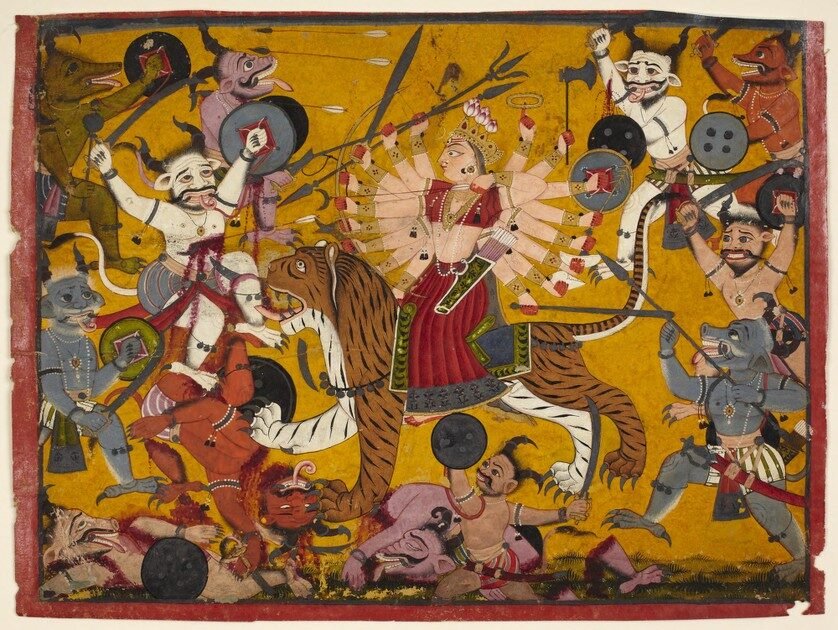
Why Is It Important?
The Devi Mahatmya is highly revered for several reasons:
- Devotional Significance: It is recited during the nine-day festival of Navaratri, a major Hindu celebration dedicated to the Goddess in her various forms.
- Philosophical Teachings: The text illustrates the cosmic struggle between dharma (righteousness) and adharma (unrighteousness), providing moral lessons about facing challenges with inner strength.
- Spiritual Power: Believers view the Devi Mahatmya as a powerful scripture capable of bestowing divine protection and blessings, especially during tough times.
The Structure of Devi Mahatmya: Three Great Battles
The Devi Mahatmya presents three major battles, each featuring the Goddess in a different form and her triumph over various demons. These stories, while mythological in nature, are full of symbolism that reflects deeper spiritual truths.
1. The Battle with Madhu and Kaitabha: Mahakali’s Victory
The first story involves the creation demons, Madhu and Kaitabha, who emerge from the earwax of the sleeping god Vishnu. These demons seek to disrupt the universe by attacking Brahma, the creator god.
To stop them, Brahma prays to Mahakali, a fearsome and powerful aspect of the Goddess. Upon her intervention, Vishnu wakes up and defeats the demons after a prolonged battle. This tale symbolizes the necessity of awakening divine power to overcome chaos.
2. The Defeat of Mahishasura: Mahalakshmi as the Warrior Goddess
In the second story, the demon king Mahishasura terrorizes both heaven and earth, pushing the gods to the brink of defeat. In their despair, they combine their divine energies to create Mahalakshmi, a warrior goddess who embodies their collective power.
Mahalakshmi takes on Mahishasura in an epic battle, where she not only defeats him but also transforms into Durga, the invincible goddess riding a lion. This story symbolizes the triumph of good over evil and reminds us of the power of righteous action when faced with overwhelming challenges.
3. Shumbh and Nishumbh: Mahasaraswati’s Final Battle
The third and final tale features the demon brothers Shumbh and Nishumbh, who conquer the heavens and lust after the goddess. When they try to force her into submission, she transforms into Mahasaraswati, another fierce form of the Goddess.
Supported by her terrifying forms like Kali and Chandika, Mahasaraswati fights the demon brothers in a series of fierce encounters. One of their strongest allies, Raktabija, poses a unique challenge—every drop of his blood that touches the ground spawns a new demon. To stop him, the Goddess drinks his blood before it hits the ground, ultimately destroying him. Shumbh and Nishumbh soon fall as well, and peace is restored to the universe.
Key Themes and Lessons
The Devi Mahatmya is more than just a collection of battle stories. It carries profound spiritual and moral messages, many of which resonate even today.
- Feminine Power as Supreme: The text emphasizes that the ultimate source of power in the universe is Shakti, the divine feminine energy. The Goddess is portrayed as not only a protector but also the creator and destroyer of worlds.
- Triumph of Good Over Evil: Each story reinforces the idea that no matter how powerful evil forces may seem, they can be overcome through divine intervention and righteous action.
- Inner Strength and Faith: The Devi Mahatmya encourages devotees to rely on their faith in the Goddess for protection and inner strength, especially in difficult times. It promotes resilience, courage, and the importance of moral values.
Why Recite the Devi Mahatmya?
For many believers, reciting the Devi Mahatmya has both spiritual and practical benefits. It is often recited during festivals, major life events, or times of crisis. The 700 verses are believed to carry immense spiritual power, offering blessings, protection from negative forces, and a deeper connection with the divine.
During Navaratri, devotees across India and other parts of the world gather in temples or at home to read or listen to the text in full. This nine-day festival celebrates the Goddess in her many forms, and the Devi Mahatmya is central to the ritual worship performed during this period.
Conclusion
The Devi Mahatmya is one of the most revered texts in Hinduism, showcasing the cosmic power of the Goddess in the eternal fight against evil. Through its vivid tales of divine intervention and victory, it not only captivates the imagination but also teaches profound lessons about faith, courage, and righteousness.
Whether you are familiar with Hindu mythology or new to it, the Devi Mahatmya offers an inspiring glimpse into the spiritual power of the divine feminine, reminding us of the strength that resides in all of us when we connect to our higher selves.

